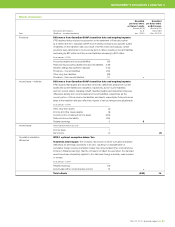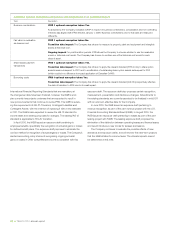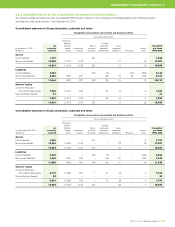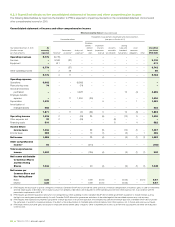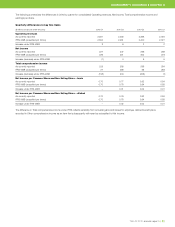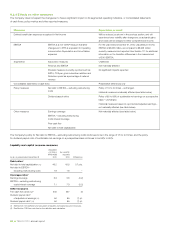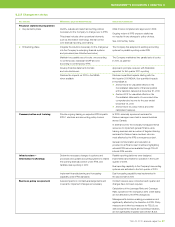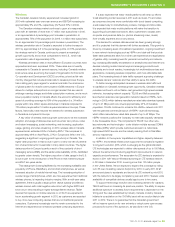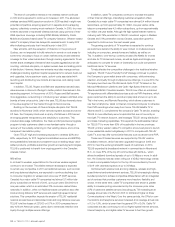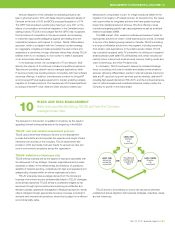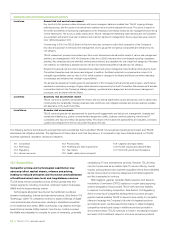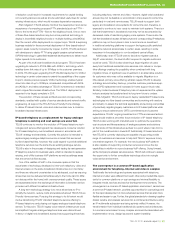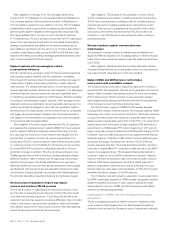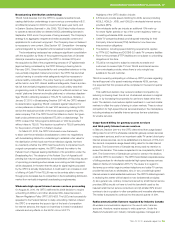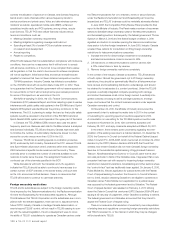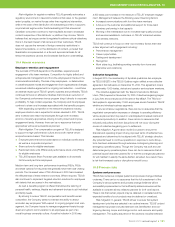Telus 2010 Annual Report Download - page 95
Download and view the complete annual report
Please find page 95 of the 2010 Telus annual report below. You can navigate through the pages in the report by either clicking on the pages listed below, or by using the keyword search tool below to find specific information within the annual report.
TELUS 2010 annual report . 91
MANAGEMENT’S DISCUSSION & ANALYSIS: 10
efficiencies to compensate, in part, for margin pressures related to the
migration from legacy to IP-based services. At the same time, this opens
new opportunities for integrated solutions that have greater business
impact than traditional telecom services. TELUS is offering a series
of solutions targeting specific high-value segments as well as small and
medium businesses (SMB).
The SMB market, often viewed as underserved because it looks for
big-business solutions at close to small-business price points, is forecast
to be one of the fastest-growing markets in Canada. TELUS is investing
in a range of affordable solutions for this segment, including everything
from email to web applications. In the small business market, TELUS
has countered increased cable-TV competition by offering an integrated
small business bundle called TELUS Business One, which includes con-
nectivity (voice, Internet and email services), security, hosting, audio and
video conferencing, and other IP-based tools.
In conclusion, TELUS continues to believe its consistent strategic
focus on providing a full suite of valuable and reliable communications
services; delivering differentiated, premium national business solutions in
data and IP; exposure to growth services such as wireless, data and IP
including high-speed Internet and TELUS TV; and the continued enhance-
ment of national wireless and broadband networks, solidly position the
Company for growth in the years ahead.
Vertical integration of the Canadian broadcasting industry has
been a growing trend in 2010 with Shaw acquiring television assets of
Canwest at the end of 2010 and BCE’s proposed acquisition of CTV.
The CRTC has scheduled a public policy hearing in June 2011 on the
effects of consolidation and vertical integration in the Canadian broad-
casting industry. TELUS is encouraged that the CRTC has recognized
the importance of competition in the carrier market, and is seeking
to implement appropriate safeguards against self-dealing and anti-
competitive behaviour with respect to content. TELUS’ differentiated
approach, which is consistent with the Company’s content strategy,
is to aggregate, integrate and make accessible the best content and
applications to customers, through whichever device they choose. TELUS
believes that it is not necessary to own content to make it accessible
on an economically attractive basis.
In the business market, the convergence of IT and telecom, facili-
tated by the ubiquity of IP, continues to shape competitive investments.
Telecoms are providing network-centric managed applications, while
IT service providers are bundling network connectivity with their software
as service offerings. In addition, manufacturers continue to bring all-IP
and converged (IP plus legacy) equipment to market, enabling a steady
migration to IP-based solutions. The development of IP-based platforms
providing combined IP voice, data and video solutions creates cost
TELUS strives to avoid taking on undue risk exposures whenever
possible and ensure alignment with business strategies, objectives, values
and risk tolerances.
The discussion in this section is qualified in its entirety by the Caution
regarding forward-looking statements at the beginning of the MD&A.
TELUS’ risk and control assessment process
TELUS uses a three-level enterprise risk and control assessment
process that solicits and incorporates the expertise and insight of team
members from all areas of the Company. TELUS implemented this
process in 2002 and tracks multi-year trends for various key risks and
control environment perceptions across the organization.
TELUS’ definition of business risk
TELUS defines business risk as the degree of exposure associated with
the achievement of key strategic, financial, organizational and process
objectives in relation to the effectiveness and efficiency of operations,
reliability of financial reporting, compliance with laws and regulations and
safeguarding of assets within an ethical organizational culture.
TELUS’ enterprise risks are largely derived from the Company’s
business environment and are fundamentally linked to TELUS’ strategies
and business objectives. TELUS strives to proactively mitigate its risk
exposures through rigorous performance planning and effective and
efficient business operational management. Residual exposure for certain
risks is mitigated through appropriate insurance coverage, including for
domestic and international operations, where this is judged to be efficient
and commercially viable.
10 RISKS AND RISK MANAGEMENT
Risks and uncertainties facing TELUS and how the Company
manages these risks
LEVEL TWO:
Quarterly
risk
assessment
TELUS Board
and Executive
Leadership
Te am
LEVEL THREE:
Granular
risk
assessment
LEVEL ONE:
Annual risk
and control
assessment


